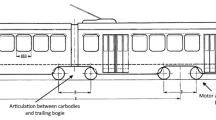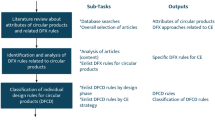Abstract
Door hinges of a large refrigerator employ a complicated mechanism in combination with crank-rockers and slide-cranks to help the doors open and close smoothly. The main frame of the hinge covering the mechanism part should support the weight of the door along with food loaded on it, and endure impact load due to the opening and closing movement of the door. Thus, the door hinges should be designed such that the mechanism part is smoothly operated and the main frame has the required strength without significantly increasing the weight. For this purpose, the deterministic design optimization (DDO) of door hinges has been studied, but it does not guarantee desirable reliabilities in the design results. In this research, reliability-based design optimization (RBDO) was carried out to obtain a more reliable design than the DDO. By comparing the RBDO results with the DO results, it was found that the RBDO results had slightly larger door weights than the DDO results, but provided much larger reliabilities. The entire process of analysis and design optimization were automated using PIDO(Progress Integration and Design Optimization) technology, where Excel was used to analyze the mechanical behavior of the hinge and ANSYS was used to carry out crash analysis.
Similar content being viewed by others
Abbreviations
- L 1 :
-
length of a bracket link
- L 2 :
-
length of a hinge lever
- L 3 :
-
length of cam link 1
- L 4 :
-
length of cam link 2
- L stop :
-
distance between cam link 1 and a stopper
- X cam :
-
X coordinate of a cam joint
- Y cam :
-
Y coordinate of a cam joint
- X slot :
-
X coordinate of a slot pin in a local coordinate
- Y slot :
-
Y coordinate of a slot pin in a local coordinate
- α :
-
angle between the bracket link and a door
- β :
-
angle between cam link 1 and cam link 2
- γ :
-
angle between cam link 2 and X-axis of the local coordinate
- θ :
-
open angle of the door
- Φ1 :
-
spring force ration of è to 0° of the door angle
- Φ2 :
-
spring force ration of 130° to 0° of the door angle
- L s :
-
distance between the cam link and a hinge exterior structure
- σ max :
-
maximum stress occurring during crash analysis of the door
- L1 :
-
length of the bracket link
References
Hwang, J. H., “Study on the Optimization of Screw Cam-Spring Frictional Hinge Mechanism for Appliance,” M.Sc. Thesis, School of Mechanical Engineering, Korea University, 2012.
Youn, S. J., Noh, Y. J., Kim, S. R., and Kim, J. W., “Optimization of Door Hinges of a Large Refrigerator,” Transactions of the Korean Society of Mechanical Engineers A, Vol. 38, No. 1, pp. 71–78, 2014.
Jeong, S. B., Lee, S. J., and Park, G. J., “Improvement of the Convergence Capability of a Single Loop Single Vector Approach using Conjugate Gradient for a Concave Function,” Transactions of the Korean Society of Mechanical Engineers A, Vol. 36, No. 7, pp. 805–811, 2012.
Oh, Y. K., “Reliability-based Shape Optimization using Evolutionary Structure Optimization and Growth Strain Method,” M.Sc. Thesis, Department of Mechanical Engineering, Hanyang University, 2010.
Kim, J. M., “Reliability-based Design Optimization of Micro Structures,” M.Sc. Thesis, Department of Automotive Engineering, Hanyang University, 2003.
Norton, R. L., “Kinematics and Dynamics of Machinery,” McGraw-Hill, Korea, pp. 56–63, 2014.
PIDO-TECH Inc., “PIAnO User’s Manual,” 2012.
Lee, G. S., Park, J. M., Choi, B. L., Choi, D. H., Nam, C. H., and Kim, G. H., “Multidisciplinary Design Optimization of Vehicle Front Suspension System using Pido Technology,” Transactions of KSAE, Vol. 20, No. 6, pp. 1–8, 2012.
Jang, J. J., “Multiplicative Decomposition Method for Accurate Moment-based Reliability Analysis,” Ph.D. Thesis, Department of Automitive Engineering, Hanyang University, 2007.
Youn, B. D., Xi, Z., Lee, J. W., and Wang, P., “Enhanced Dimension-Reduction (eDR) Method for Sensitivity-Free Uncertainty Quantification,” Proc. of 11th AIAA/ISSMO Multidisciplinary Analysis and Optimization Conference, 2006.
Korea Industrial Standards, “General Dimensional Tolerances for Parts Formed by Press Working from Sheet Metal,” KS B 0413, 2011.
Author information
Authors and Affiliations
Corresponding author
Rights and permissions
About this article
Cite this article
Youn, SJ., Noh, Y. Reliability-based design optimization of refrigerator door hinges using PIDO technology. Int. J. Precis. Eng. Manuf. 16, 715–722 (2015). https://doi.org/10.1007/s12541-015-0095-0
Received:
Revised:
Accepted:
Published:
Issue Date:
DOI: https://doi.org/10.1007/s12541-015-0095-0




